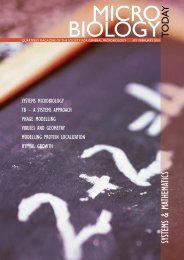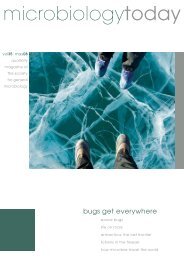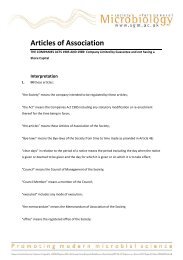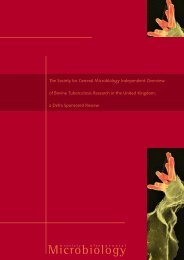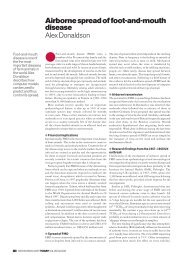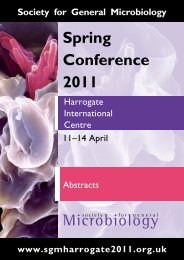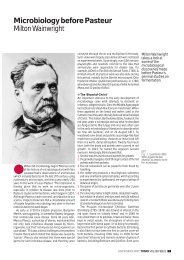Download - Society for General Microbiology
Download - Society for General Microbiology
Download - Society for General Microbiology
You also want an ePaper? Increase the reach of your titles
YUMPU automatically turns print PDFs into web optimized ePapers that Google loves.
National<br />
Subject<br />
Profile<br />
<strong>for</strong><br />
higher<br />
education<br />
programmes<br />
in<br />
microbiology<br />
The Higher Education Academy<br />
recently launched a landmark<br />
series of National Subject<br />
Profiles, researched and written<br />
by the Academy’s Subject<br />
Centres. In<strong>for</strong>med by discipline<br />
communities and practitioners, each<br />
Profile provides an evidence-based<br />
overview of higher education provision<br />
in a specific discipline, summarizing the<br />
range of learning experiences available<br />
and highlighting areas <strong>for</strong> development.<br />
Two Profiles were produced<br />
by the HEA Centre <strong>for</strong> Bioscience –<br />
<strong>Microbiology</strong> and Biochemistry.<br />
Each Profile was managed by a<br />
panel comprising representatives<br />
from academia, employers, students<br />
and learned societies. Sue Assinder<br />
(SGM Education Officer) chaired the<br />
<strong>Microbiology</strong> panel and Janet Hurst<br />
was a member to represent the various<br />
microbiology learned societies. The<br />
panel used data in the public domain<br />
where this was available (e.g. centrally<br />
published by funding councils and the<br />
results of the National Student Survey).<br />
Where new data were required, the<br />
panel was grateful <strong>for</strong> the help of SGM<br />
representatives in several academic<br />
departments who provided in<strong>for</strong>mation<br />
about their programmes and also<br />
allowed their students to be surveyed<br />
about their learning experiences. The<br />
panel also made use of data collected<br />
by the SGM, such as the degree<br />
programmes followed by winners of<br />
SGM undergraduate prizes.<br />
The Profile reviews current provision<br />
in relation to the historical<br />
development of microbiology as a teaching discipline<br />
and its significance <strong>for</strong> society, <strong>for</strong> the economy and on<br />
research in other biosciences. It details the current range<br />
of higher education undergraduate and taught postgraduate<br />
programmes, including their curriculum content and<br />
the key teaching, learning and assessment patterns. Data<br />
are presented on trends in staffing profiles, student entry<br />
profiles, student numbers and graduate destinations. There<br />
are also some baseline comparisons with other countries,<br />
including models of provision elsewhere and transferability<br />
of qualifications.<br />
A key message is that students wishing to study microbiology<br />
at university are offered programmes that are<br />
exciting, relevant and diverse in their approaches to teaching,<br />
learning and assessment. The nature of undergraduate<br />
provision is very varied, and this enables students to choose<br />
a programme that meets their needs in terms of teaching<br />
and assessment methods used, support provided, options<br />
available and specialisms taught. Although there has been<br />
concern in the sector in recent years about the decrease in<br />
the number of ‘named’ microbiology programmes on offer,<br />
the Profile shows that large numbers of undergraduate<br />
students are still being exposed to a substantial amount<br />
of microbiology teaching. Although any loss of ‘named’<br />
programmes is to be regretted from the perspective of<br />
maintaining the profile of the discipline, the Profile provides<br />
reassuring data about the number of students graduating<br />
with the relevant microbiological knowledge. Data on<br />
graduate destinations show that microbiology degrees<br />
provide entry to fascinating and varied careers both within<br />
and outside the biosciences.<br />
The microbiology students surveyed were generally very<br />
positive about their experiences. Most reported that their<br />
lecturers were enthusiastic, that their practical and generic<br />
skills had been developed effectively and that they would<br />
recommend their degree programme to others. They were<br />
more negative about aspects flagged nationally as concerns<br />
in the annual National Student Survey, such as feedback,<br />
career guidance and availability of relevant work experience.<br />
Against this largely positive backdrop, the evidence<br />
presented in the Profile highlights important educational and<br />
intellectual issues. These include the need <strong>for</strong> the curriculum<br />
to reflect the societal and economic impacts of microbiology<br />
and to keep pace with the rapid expansion of knowledge<br />
in this field. Alongside this, programmes must meet the<br />
needs and support the career aspirations of all students<br />
by achieving an appropriate balance between disciplinespecific<br />
knowledge and transferable skills. And, crucially,<br />
students must have adequate opportunities to develop skills<br />
in practical microbiology, including wherever possible the<br />
availability of laboratory-based final year research projects.<br />
These are highlighted as priority areas <strong>for</strong> future development<br />
by the HEA Centre <strong>for</strong> Bioscience.<br />
Resource issues are also emphasized, including the need<br />
<strong>for</strong> adequate funding per student to support a laboratoryintensive<br />
experience and the availability of appropriate<br />
teaching space. Attention is also drawn to the tensions often<br />
faced by academic staff when dividing their time between<br />
research and teaching, and the recognition of the latter as<br />
an appropriate career option.<br />
Those involved in producing the <strong>Microbiology</strong> Profile<br />
hope that it will be a useful reference <strong>for</strong> both academics and<br />
students, together with a wide range of other groups such<br />
as employers, careers advisors and prospective applicants.<br />
It is a starting point <strong>for</strong> discussion about how university<br />
microbiology programmes can best meet the needs of both<br />
students and employers and ensure a continued flow of<br />
microbiology graduates that is commensurate with the<br />
demands of the UK economy. It gives academic departments<br />
in<strong>for</strong>mation from which to reflect on the appropriateness of<br />
their own programmes and provides a foundation that can<br />
be updated periodically to enable continual enhancement of<br />
the student learning experience.<br />
The <strong>Microbiology</strong> and Biochemistry Profiles can be<br />
downloaded from the website of the HEA Centre <strong>for</strong><br />
Bioscience (www.bioscience.heacademy.ac.uk/events/themes/<br />
sled.aspx).<br />
Sue Assinder<br />
SGM Education Officer<br />
196 microbiology today nov 08 microbiology today nov 08 197



